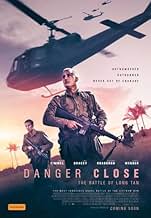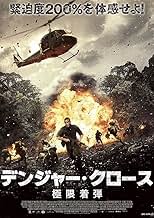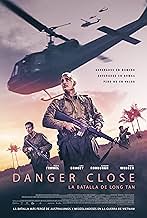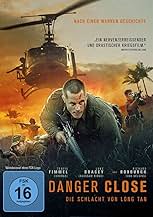AVALIAÇÃO DA IMDb
6,8/10
16 mil
SUA AVALIAÇÃO
Em agosto de 1966, em uma plantação de borracha vietnamita chamada Long Tan, 108 soldados jovens e inexperientes da Austrália e Nova Zelândia lutam por suas vidas contra 2500 soldados do Vie... Ler tudoEm agosto de 1966, em uma plantação de borracha vietnamita chamada Long Tan, 108 soldados jovens e inexperientes da Austrália e Nova Zelândia lutam por suas vidas contra 2500 soldados do Vietnã do Norte e Viet Cong.Em agosto de 1966, em uma plantação de borracha vietnamita chamada Long Tan, 108 soldados jovens e inexperientes da Austrália e Nova Zelândia lutam por suas vidas contra 2500 soldados do Vietnã do Norte e Viet Cong.
- Direção
- Roteiristas
- Artistas
- Prêmios
- 8 vitórias e 6 indicações no total
Rihari Te Are
- Gunner Murry Watene
- (as Richard Te Are)
Avaliações em destaque
Went to the first public screening at the Sydney Film Festival tonight with members of my family and sat in the front row in a packed cinema. Director Kriv Stenders has taken a big undertaking in telling this highly recognised Australian and New Zealand battle of the Vietnam War that has however been long overdue in getting a major screen treatment. He has succeeded brilliantly. The film's relentless action and attention to detail are mixed in with moving scenes of young conscripts and volunteer soldiers grappling to stay alive in order to return to their loved ones at home. Much like Peter Weir's Gallipoli the mateship ethos shines in this movie. However, unlike that film, most of Danger Close concentrates on the battle itself, and what a technically amazing film it is in presenting and creating a visceral and tense atmosphere for the audience.The performances are excellent all round but particular mention must go to Daniel Webber as Private Paul Large, his moving portrayal of a young conscript struggling and battling courageously to help his mates and himself survive, while looking forward to returning home to his fiance and family is brilliant. As noted earlier the action in this film is relentless, from start to finish, however it never ignores the humanity and futility of war through the loss of life of many young soldiers. The roll call of ANZAC soldiers who died in the battle, noted at the end of the film with their ages, makes that abundantly clear. HIGHLY RECOMMENDED.
As movies about real battles go, this one holds its own.
If I have a criticism it would be what director Kriv Stenders himself was worried about when he showed the film to the real Harry Smith and veterans of the battle. Stenders was concerned "... that a cinematic interpretation of the film, overdramatizing some moments and fictionalizing others, would be an issue with veterans of the battle".
Although Harry Smith told Stenders he thought the film was great, I feel those scenes, especially the exchanges between Major Smith (Travis Fimmel) and Private Large (Daniel Webber), the stereotypical "Hollywood" stuff, do sound a false note. However, the film is a technical triumph with a superb score and, for the most part, seems honest to events.
The film is similar to Mel Gibson's "We Were Soldiers": the unexpected enemy force; the cut-off platoon; helicopter pilots defying orders to provide aid and impressive firepower that doesn't overshadow the discipline and guts of the troops on the ground. Both were straightforward battles without civilians caught in the crossfire.
As an Australian, I'm not sure how non-Australian audiences will view "Danger Close". The accents could be challenging and the look of the Australians and New Zealanders is noticeably different to the helmeted U.S. Army and Marines familiar from documentaries and newsreels. Ever since the war, the respective tactics of the allies have been dissected in books and back-and-forth sessions on military history blogs. The Diggers of that era actually looked like the U.S. Army LRRPs or even the VC; styled for jungle warfare.
Another thought, a great victory is only in proportion to the toughness of the enemy. All accounts I've read also acknowledge the bravery of the Vietnamese. You do see it in the film, but it could have been stated.
Despite the rights and wrongs of Australia's involvement, Long Tan has emerged as one of our most iconic battles. Maybe it's partly guilt over the way Vietnam veterans were neglected for so long. Maybe it's also because not much was expected of the "Baby Boomers", but they stood up nonetheless.
Like Peter Weir's "Gallipoli", "Danger Close" will probably be how future generations will know this battle. With that in mind, the filmmakers and the stars, despite the odd flaw, have left us with a powerful and affecting experience.
If I have a criticism it would be what director Kriv Stenders himself was worried about when he showed the film to the real Harry Smith and veterans of the battle. Stenders was concerned "... that a cinematic interpretation of the film, overdramatizing some moments and fictionalizing others, would be an issue with veterans of the battle".
Although Harry Smith told Stenders he thought the film was great, I feel those scenes, especially the exchanges between Major Smith (Travis Fimmel) and Private Large (Daniel Webber), the stereotypical "Hollywood" stuff, do sound a false note. However, the film is a technical triumph with a superb score and, for the most part, seems honest to events.
The film is similar to Mel Gibson's "We Were Soldiers": the unexpected enemy force; the cut-off platoon; helicopter pilots defying orders to provide aid and impressive firepower that doesn't overshadow the discipline and guts of the troops on the ground. Both were straightforward battles without civilians caught in the crossfire.
As an Australian, I'm not sure how non-Australian audiences will view "Danger Close". The accents could be challenging and the look of the Australians and New Zealanders is noticeably different to the helmeted U.S. Army and Marines familiar from documentaries and newsreels. Ever since the war, the respective tactics of the allies have been dissected in books and back-and-forth sessions on military history blogs. The Diggers of that era actually looked like the U.S. Army LRRPs or even the VC; styled for jungle warfare.
Another thought, a great victory is only in proportion to the toughness of the enemy. All accounts I've read also acknowledge the bravery of the Vietnamese. You do see it in the film, but it could have been stated.
Despite the rights and wrongs of Australia's involvement, Long Tan has emerged as one of our most iconic battles. Maybe it's partly guilt over the way Vietnam veterans were neglected for so long. Maybe it's also because not much was expected of the "Baby Boomers", but they stood up nonetheless.
Like Peter Weir's "Gallipoli", "Danger Close" will probably be how future generations will know this battle. With that in mind, the filmmakers and the stars, despite the odd flaw, have left us with a powerful and affecting experience.
A lot more soldiers have been killed in single battles in other wars, but not boys from a nation so young as ours was in Vietnam, August 1966.
Director Kriv Stenders honed his craft in 20 years of Australian television before tackling the sticky subject of our involvement in the Vietnam war, for the big screen. The story he chose, the battle of Long Tan, eptiomises the mess Vietnam was for anti-communist allied military.
Our small number of troops had no fighting experience in the terrain and climate of south east asia. Our government instated conscription to find the troop numbers it was tasked with sending, in support of the U.S., New Zealand, and a handful of developing anti-communist asian countries. North Vietnam (communist Viet Cong) were well equipped by the U.S.S.R. and China, and knew their battle ground well. This battle of Long Tan story isn't a turning point in the war. It is a frightening reality of how close fragile human beings are to catastrophe when battlefield circumstances quickly change.
Stenders executes the story with a firm, professional hand from the outset. Ben Nott's camera work thoroughly enhances the atmosphere, character development and storyline. Visual and special effects were seriously well embedded in the action. Production values are excellent throughout. Sound and editing also deserve a special mention. While I felt he stunts got off to a slow start, once the director and cameraman found their stride, the impact of the firefights was ferocious and all too believable. This was no mean feat. A good two thirds of this movie is from the POV of young conscripts, pinned under heavy fire, surviving and surrounded by exploding artillery. Stenders manages to keep us sufficiently connected to the characters amid this deadly chaos, without resorting to usual battlefield cliche's. The result is gripping, and at times heartbreaking. And, much to Stenders credit, there isn't a wasted frame.
There are a lot of good performances rung in in this movie. Travis Fimmel nails his Majory Harry Smith role and captures the screen. This fella can act, and he knows what he gives the camera. He imbues each scene with appropriate weight and intensity. Richard Roxburgh is at the peak of his film acting powers in this one. He could have made his antagonistic Brigadier Jackson into a two dimensional character and gotten away with it. But he, too, shows his craft. He provides us solid glimpses of Jackson's conflict and humanity, trapped beneath the institution of his command.
I've said this in other reviews, and it holds true for this one. The supporting cast is uniformly good. I'm leaving many names out here that should be included, but just peruse the cast list for those not mentioned. They all equally deserve to be. Daniel Webber as the fresh faced Private Large, Nicholas Hamilton's Private Grimes,Mojean Aria's Second Lieutenant Gordon Sharp, Stephen Peacocke, Luke Bracey, Myles Pollard and Uli Latukefu, who stole scenes amid firing field artillery, show how well directed this movie is, and how much this story meant to the actors. That there was room in this film to lend the enemy a more human face is a small criticism given what is acheived. The battle of Long Tan was a frightening punctuation point in our history. While Stender's film reveals itself a study of courage under fire, it has taken Australia decades to fully understand the cost of sending these19, 20, 21 year old conscripts into battle. I hope we learn from history, this lesson is never to be repeated.
Our small number of troops had no fighting experience in the terrain and climate of south east asia. Our government instated conscription to find the troop numbers it was tasked with sending, in support of the U.S., New Zealand, and a handful of developing anti-communist asian countries. North Vietnam (communist Viet Cong) were well equipped by the U.S.S.R. and China, and knew their battle ground well. This battle of Long Tan story isn't a turning point in the war. It is a frightening reality of how close fragile human beings are to catastrophe when battlefield circumstances quickly change.
Stenders executes the story with a firm, professional hand from the outset. Ben Nott's camera work thoroughly enhances the atmosphere, character development and storyline. Visual and special effects were seriously well embedded in the action. Production values are excellent throughout. Sound and editing also deserve a special mention. While I felt he stunts got off to a slow start, once the director and cameraman found their stride, the impact of the firefights was ferocious and all too believable. This was no mean feat. A good two thirds of this movie is from the POV of young conscripts, pinned under heavy fire, surviving and surrounded by exploding artillery. Stenders manages to keep us sufficiently connected to the characters amid this deadly chaos, without resorting to usual battlefield cliche's. The result is gripping, and at times heartbreaking. And, much to Stenders credit, there isn't a wasted frame.
There are a lot of good performances rung in in this movie. Travis Fimmel nails his Majory Harry Smith role and captures the screen. This fella can act, and he knows what he gives the camera. He imbues each scene with appropriate weight and intensity. Richard Roxburgh is at the peak of his film acting powers in this one. He could have made his antagonistic Brigadier Jackson into a two dimensional character and gotten away with it. But he, too, shows his craft. He provides us solid glimpses of Jackson's conflict and humanity, trapped beneath the institution of his command.
I've said this in other reviews, and it holds true for this one. The supporting cast is uniformly good. I'm leaving many names out here that should be included, but just peruse the cast list for those not mentioned. They all equally deserve to be. Daniel Webber as the fresh faced Private Large, Nicholas Hamilton's Private Grimes,Mojean Aria's Second Lieutenant Gordon Sharp, Stephen Peacocke, Luke Bracey, Myles Pollard and Uli Latukefu, who stole scenes amid firing field artillery, show how well directed this movie is, and how much this story meant to the actors. That there was room in this film to lend the enemy a more human face is a small criticism given what is acheived. The battle of Long Tan was a frightening punctuation point in our history. While Stender's film reveals itself a study of courage under fire, it has taken Australia decades to fully understand the cost of sending these19, 20, 21 year old conscripts into battle. I hope we learn from history, this lesson is never to be repeated.
Close calls and other things that indicate that danger is ... well close by. As the title already tells you, this is about the Battle of Long Tan. I was not really aware of that battle or what went down and who won (no pun intended). And I did not just pick this from my Prime to watch because one very well known Vikings actor is in it. It was fun to see him in something else than in a Vikings setting though.
And he is front and center again in this one. He has to make decisions that have impact on not just him and his crew, but many others. Now war movies are tough to watch - but if they are as well made as this one, they are also quite beautiful (and yes I'm aware of the irony, especially in this very vivid effort, that shows us the repercussions)! For some this may feel a bit over the top at places, but overall it does stay grounded. And has us in the middle of it all ... not for the faint of hearted for sure
And he is front and center again in this one. He has to make decisions that have impact on not just him and his crew, but many others. Now war movies are tough to watch - but if they are as well made as this one, they are also quite beautiful (and yes I'm aware of the irony, especially in this very vivid effort, that shows us the repercussions)! For some this may feel a bit over the top at places, but overall it does stay grounded. And has us in the middle of it all ... not for the faint of hearted for sure
There's not much wrong with this film, but don't get taken in by the hyperbole in a lot of the reviews here. It certainly isn't a 10/10, and it isn't the greatest war film ever made - it's not even close to that. It's a solid, watchable film, about a real event that means a lot to Australian and Kiwi forces.
There's some decent action sequences, although I'd credit the Vietcong with slightly better tactics than simply running blindly towards automatic weapons, which seems to be the default for most of the film. You can also have fun ticking off the war film cliches - likeable character talking about what he's going to do when all this is over - check, man in desperate situation calling in fire support on his own position - check.
If you want an independent film that might actually be one of the greatest war films ever made, I'd strongly recommend Kajaki - this really isn't in the same league, good though it is.
There's some decent action sequences, although I'd credit the Vietcong with slightly better tactics than simply running blindly towards automatic weapons, which seems to be the default for most of the film. You can also have fun ticking off the war film cliches - likeable character talking about what he's going to do when all this is over - check, man in desperate situation calling in fire support on his own position - check.
If you want an independent film that might actually be one of the greatest war films ever made, I'd strongly recommend Kajaki - this really isn't in the same league, good though it is.
Você sabia?
- CuriosidadesThe term, "Roger that", is an Americanism, originally from CB radio culture, and often used in military movies. However, it would never be said (or permitted, by any NCO or Officer within earshot) in the Australian Army. "Roger" is the only accepted proword. Similarly, the phrase, "I repeat", when repeating some for clarity over the radio telephone (RATEL), is not permitted. Instead the operator would use, "I say again...". This is because "repeat" is a proword used when directing artillery or naval fire (e.g "request for the same volume of fire to be fired again with or without corrections or changes")
- Erros de gravaçãoThe entire battle took place in a torrential tropical downpour from start to finish. Evidently, this would be hard to film for dramatic purposes. The airstrike never happened not because of a dud smoke grenade, but the cloud was so low and rain so intense the pilots could not identity the target area.
- Citações
Major Harry Smith: There's a thousand ways to die in a war zone.
- Cenas durante ou pós-créditosPart way through the final credits, after showing the actors and pictures of their real life counterparts and some of the principal credits, acknowledgment of the 6RAR's Presidential Unit Citation from the USA made in 1968 but that Australia took 45 years to acknowledge the soldiers who fought in a similar way.
This is followed by an Honour Roll of the Australian Soldiers killed during this battle.
- ConexõesFeatured in Danger Close: Behind the Scenes (2019)
Principais escolhas
Faça login para avaliar e ver a lista de recomendações personalizadas
- How long is Danger Close?Fornecido pela Alexa
Detalhes
- Data de lançamento
- País de origem
- Centrais de atendimento oficiais
- Idiomas
- Também conhecido como
- Danger Close: The Battle of Long Tan
- Locações de filme
- Empresas de produção
- Consulte mais créditos da empresa na IMDbPro
Bilheteria
- Orçamento
- AU$ 24.000.000 (estimativa)
- Faturamento bruto mundial
- US$ 2.092.198
- Tempo de duração1 hora 58 minutos
- Cor
- Proporção
- 2.35 : 1
Contribua para esta página
Sugerir uma alteração ou adicionar conteúdo ausente

Principal brecha
By what name was Perigo Iminente (2019) officially released in India in Hindi?
Responda









































